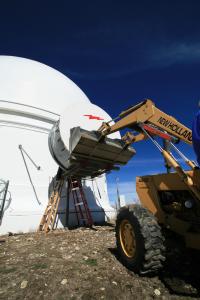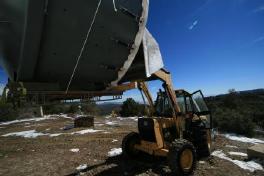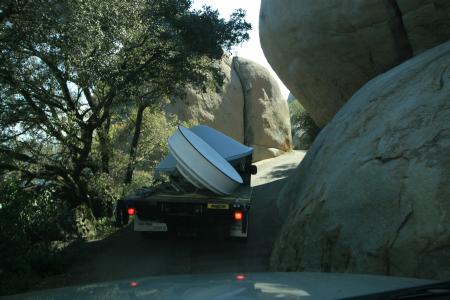
|
|
April 4, 2008
Caltech's Palomar Observatory now upgraded to 155Mbps connectivity via HPWREN
An upgrade of major parts of the HPWREN backbone from 45 megabits per second to 155 Mbps (OC-3 capacity) terrestrial microwave links is now boosting the network performance of the California Institute of Technology's Palomar Observatory. Besides the National Science Foundation funding for HPWREN, Caltech's cost sharing for some of the equipment and installation staff enabled this change. Additional cost sharing is provided by the Lawrence Berkeley National Laboratory by paying monthly tower rental for the antenna at a relay site pointed at the Palomar Observatory. "From the very start, the HPWREN network enabled forefront wide-field surveys at Palomar, which have so far discovered hundreds of supernovae, asteroids and quasars," explains Greg Aldering, a staff scientist at the Lawrence Berkeley National Laboratory, and leader of the Nearby Supernova Factory. "This leap in the speed of the HPWREN network will enable even more ambitious studies, and ensure that the Palomar telescopes will remain at the forefront of time-domain astronomy." Greg Aldering was the astronomy scientist originally contacting HPWREN in 2001 about having the Palomar Observatory added to the HPWREN cyberinfrastructure. "The upgrade to 155Mbps for a large part of the HPWREN backbone was really driven by the high data volume requirements of the Palomar Observatory, which for years already often ran the backbone flat out for large amounts of time at night, dominated by just a single network application from a camera at one of their telescopes," adds HPWREN's Principal Investigator Hans-Werner Braun. "The bandwidth increase and the multi-channel full-duplex radios used for the links nicely fit into HPWREN's hybrid "Quality of Service" approach of QoS-based queue management in the routers and policy based routing, alongside planned network capacity upgrades, based on network analysis and workload profiling." The upgrade, following the prototype link described at /news/20080107, was a real team effort, with the installation of the large antennas coordinated by Jim Hale. Dan Zieber (Caltech) participated in installing the whole path. Other Caltech staff, including Merle Sweet and Mike Doyle, helped with the installation at the Observatory itself. Pablo Bryant (San Diego State University) was one of the most active participants. Mike Datte (San Diego Supercomputer Center) helped at some of the sites. Susan Teel (National Park Service) had organized two people, Mike Maki (NPS Santa Monica) and Daren Fairbanks (NPS Death Valley), to actively participate in an installation as part of a technology and expertise transfer. Additional HPWREN staff included Ron Serabia and Hans-Werner Braun. "The Observatory's partnership with HPWREN has proven to be a tremendous boon to our astronomical research," said W. Scott Kardel, Public Affairs Coordinator, Palomar Observatory. "The high-speed data transfer allows our automated and other telescopes to receive and send data and commands to and from astronomers as never before, allowing them to explore the universe in new and innovative ways. Much of the new astronomy being explored at Palomar involves short-lived transient phenomena. Time is of the essence, and the new even-faster link via HPWREN allows Caltech astronomers to catch these events before they fade into oblivion."
|










